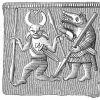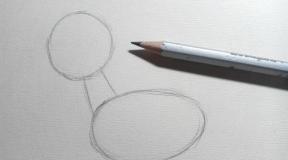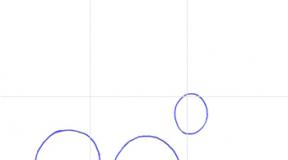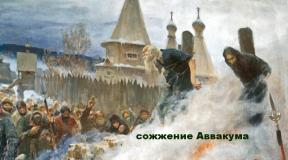We learn to write with preschool children without mistakes. How to teach a five-year-old to write numbers and letters? We write correctly: attention to the letter
Schooling almost always involves a lot of effort. Moreover, both on the part of the child and his responsible parents. And one of the fundamental points for a student for all his school years (and not only) is the ability to write correctly.
However, as important as this skill is, it is just as difficult to develop. Errors in the notebooks of a student of any class do not surprise anyone. However, if they are repeated over and over again, this becomes a cause for concern for parents and teachers.
In this case, it is important to find out why literacy suffers: is it only the child's lack of attentiveness and perseverance that is to blame, or does the reason have a medical explanation?
What is dysgraphia?
Today, children are increasingly diagnosed with dysgraphia. This is a disorder in which the child is unable to learn writing skills. At the same time, he may know the rules of the Russian language by heart, but when it comes to practice, the student cannot write without mistakes.
Dysgraphia is expressed by the following "symptoms" for which one should be alert:
- the child writes unnecessary elements of letters or, conversely, does not add letters;
- some letters and numbers are written in mirror image;
- letters are often missing in words;
- in writing, the child rearranges the syllables in places;
- letters are repeated in the word ("lalina" instead of "raspberry", etc.);
- there may be no spaces between words, periods between sentences;
- the lines often continue beyond the margins of the notebook.
If such phenomena are systematic, it will not be possible to master an error-free letter in a short time. However, the situation is fixable. If the mistakes are of a different nature, the fault is the baby's inattention, which will also be dealt with over time.
How to help a student write correctly with dysgraphia?
If you suspect that a child has such a disorder, you should first of all contact a good speech therapist.
 When confirming the diagnosis, the parents have to do painstaking work:
When confirming the diagnosis, the parents have to do painstaking work:
"Magic dictation"
You can teach your child not to miss letters using the Magic Dictation game. Before you write a phrase of 3-4 words, you need to determine (tap) how many syllables there are in each of them, and fix each with a dash. In the next step, not syllables are indicated, but letters - by dots.
Mastering vocabulary words
If the child is not given vocabulary words, you can try to make a story out of them with him: the parent dictates the sequence of words to the child, and he comes up with a plot with them, pronouncing the correct spelling by syllables.
The sequence is then dictated again and a self-test is performed. You can also resort to drawing, highlighting the spelling (for example, the sun with the letter "l" inside).
"Foreign reading"
No less effective is the "Foreign Reading" method, in which the child must read 5-15 minutes a day (depending on age) spelling, that is, as it is written ("Give a cow's milk"). This is how the visual images of the words are fixed. For such reading, it is best to use a spelling dictionary.
"Pencil" dictations and cheating
Arrange for the kid with dysgraphia "pencil" dictations and cheating: let the child write with a pencil, then he checks each word himself and erases the wrong letters with an eraser, entering the necessary ones. As a result, you will get a clean and competent text, which will be an excellent motivation for the student.
 In addition to these exercises, there are many others. They are aimed not only at developing the skill of correct writing, but also at stimulating the brain in general, which has a beneficial effect on the student's academic performance.
In addition to these exercises, there are many others. They are aimed not only at developing the skill of correct writing, but also at stimulating the brain in general, which has a beneficial effect on the student's academic performance.
Among them:
- games with constructor and puzzles,
- sewing on buttons,
- weaving from beads and beads,
- drawing miniatures,
- burning out - in general, everything that develops fine motor skills and makes both hemispheres of the brain work.
How can I help my child cope with inattention?
As we have already found out, not all schoolchildren make mistakes in their notebooks due to dysgraphia, most of them receive bad grades in writing due to banal carelessness. It is not worth scolding children for this, but it is necessary to correct the situation.
In this case, games and exercises to develop the child's attention come to the rescue.
Here are some of them:
"Corrector"
Offer your baby to be a proofreader. At first, give the child the task to find a certain letter in the text and mark it. For older students, you can prepare a text with errors and ask to correct them, along the way pronouncing the rules of the Russian language, according to which this or that letter should be written.
 So in the child's memory both the rule itself and the correct spelling of the word will be fixed. Such correction of texts written earlier by the student himself gives a good effect.
So in the child's memory both the rule itself and the correct spelling of the word will be fixed. Such correction of texts written earlier by the student himself gives a good effect.
Games for changing the composition of objects and logic
Games like “What has changed?”: The child looks at a sequence of objects (drawings, toys, etc.) for some time, then turns away, and the parent removes one object or rearranges the objects. The kid-player will have to determine what has changed.
All kinds of board games for logic: walkers, chess, checkers and backgammon, even "sea battle" - all of them will give a positive result. Puzzles and constructors are also good.
In addition, attention and writing skills can be developed in a child in other ways. The most important of these is reading. Read together, syllabically and fluently, regularly, with interest. On walks, notice signs and announcements, price tags, determine if there are errors on them.
In addition to reading and exercise, it is certainly important for the student to organize the correct diet and daily routine, outdoor games, dancing or sports. All this will keep the brain in good shape, while not straining it unnecessarily, which means that it will be faster to teach a child to write without mistakes.
Parents and teachers sometimes just shrug their shoulders when they fail to teach their child to write correctly. It would seem that both the theoretical rules have been mastered, and the practice is constant, but there is no progress in mastering literacy. The statistics are especially frightening. Most of today's schoolchildren have problems with spelling and punctuation, not to mention the ability to correctly structure the text.
How to properly sit at a writing desk?
Every detail counts to achieve the desired result. How to teach a child to write correctly without mistakes and where to start learning? Sitting correctly at your workplace is the first step to mastering literacy:

How to distinguish from dysgraphia?
Adults often fail to understand that a child has severe speech impairments on paper. Even experienced teachers may mistakenly think that he is corny lazy. In fact, dysgraphia is not that difficult to define. You should just take a closer look at the notes of the little student. Usually errors in this deviation have their own distinctive features. You should contact a speech therapist if the child makes the following mistakes:

Who is prone to dysgraphia?
Are there any risk groups? Everyone wants to know how to teach a child to write correctly without mistakes. But you should think about how to avoid the appearance of a problem from a very young age. Parents should pay attention if:

Types of dysgraphia:
- Articulation-acoustic problem. The student confuses sounds, does not perceive them and cannot pronounce them correctly. Because of this, he cannot write correctly.
- Phonetic perception. The child distorts what he hears.
- Violation of language analysis and synthesis. Skipping letters and syllables, parts of words.
- Agrammatic. It arises from ignorance of the rules.
- Optical. The child confuses words that are similar in spelling.
How can you help?
You should think about how to teach a child to write without mistakes as early as possible. You need to pay a lot of attention to such a child both at school and at home. Only with a systematic approach can a positive result be achieved. Psychologists and speech therapists provide some useful advice for parents:
- Keep a close eye on what mistakes were made during the day. Doing homework, you can unobtrusively pronounce the correct words, thus repeating spelling.
- Try to instill in your child a love of reading. Well-read people make far fewer mistakes thanks to automatic memory. In the future, the child may not know the rules, but must write properly.
- Pay attention to words that your child encounters in everyday life. Signs, advertisements, TV - emphasize the correct spelling of difficult words.
The most important rule is not to scold or criticize the child. It is not his fault that he has such a problem, and if you underestimate self-esteem, you can only achieve even greater regression. Parents are simply obliged, first of all, to work on their own, to spare no time, to study the issue. There is a wide variety of specialized literature. For example, a series of books by Shklyarova can be very useful. Shklyarova tells how to teach a child to write without mistakes, explains easily and easily.

How to treat and correct dysgraphia?
Treatment of dysgraphia and dysorformography, first of all, should be based on the elimination of the causes of violations, as well as contain the correct and timely correction of the letter. It is imperative to consult a neurologist and speech therapist. If concomitant diseases are identified, it is necessary to undergo a rehabilitation course, which may consist of physiotherapy exercises and physiotherapy. All violations in the letter are corrected by a speech therapist. The developed methods allow:
- develop skills to visually distinguish between letters and symbols;
- to teach the skills of analyzing and synthesizing information, in other words, to compare, contrast, identify patterns;
- develop visual and auditory memory;
- teach basic morphological principles;
- help the child pronounce sounds and understand phonetic processes;
- enrich vocabulary;
- form a coherent speech in a child.
How to prepare your child for school?
Typically, spelling problems are found in the first grade. If you are thinking about how to teach your child to write dictations without mistakes in a short time, 2nd grade is the best time to get started. The second grade is the period when children are faced with dictation. In older grades, if a student does not master the spelling, he will have problems with tests, which means bad grades. Preparation for this important spell checker should start gradually, in several steps:
- repeat familiar spelling rules;
- constantly practice writing unfamiliar words;
- apply the rules in practice;
- take dictation at least a few small sentences a day;
- repeat the spelling of words in which mistakes were made;
- pay attention to pauses during dictation;
- start writing only after the sentence has been read to the end.

Rules for writing dictations that a child should know
The question of how to teach a child to write dictations without mistakes in a short time may seem difficult, but it is not. Don't be afraid of difficulties. You just need:
- Explain to the little student that the most important thing is not to rush.
- Don't write when you need to listen.
- Do not write off.
- When writing, you can mentally pronounce the word by syllable.
- When the teacher reads the second time, you need to carefully monitor what is written in the notebook.
- Re-read your work several times.
- Be patient with your child. It takes a lot of time for adults to achieve results, but for children, due to their age, it is much more difficult.
- Do not scold for bad grades.
- Praise even minor successes.
- Try to compete with him. You can sometimes give in, because trying to write better than an adult is the main interest of the kid. During such competitions, you can invite the child to find mistakes with the mother.
- Get a special copybook. Let the daughter or son write down her favorite verses, excerpts from works.
- Monitor the child's attentiveness - let him try not to be distracted by anything.
- If you took up dictations, you need to pronounce every word correctly, make reasonable pauses.
- Try to write visual dictations.
- Make sure your student speaks what he writes.
- Do not overload the child.
- Develop hand motor skills.
- Walking in the fresh air a lot, even if this, at first glance, does not apply to the question of how to teach a child to write correctly without mistakes, oxygen is very helpful for good brain function.
Parenting Tips: How to Teach Your Child to Write Without Errors
The list of tips on how to teach your child to write correctly without mistakes is actually not that difficult to master. Patience and caring for your baby will definitely help you get a good result.
Theoretically, we have already figured out how to teach a child to write dictations without mistakes. But what are the practical tips and exercises for developing literacy in a child? You can get an individual correction system from a speech therapist. How you can teach a child to write carefully without mistakes, say modern experts. By the way, even ten years ago, no one spoke about the problem of dysgraphia.
1. Analyze words
The first thing to do is to tell the child about the basic phonetic principles. He must be able to distinguish between soft and hard sounds, deaf and voiced. Play with your child matching words that start with the specified sound. Let him try to do and syllables in the word
2. Find a letter
Offer your child text in which to find and cross out, for example, all the letters "m". As soon as he copes - all the letters "l". Etc. Fix the time so you can follow the dynamics. Over time, it can become more complicated: one and the other letters are distinguished in different ways. For example, cross out the letter "a" with one line, the letter "l" with two.
3. Speak words constantly
Teach your child to speak clearly. Emphasize that not all words are pronounced and spelled the same. Also teach to highlight the endings in words, because such dissonance is most often found in this part.
4. How many words are in a sentence
Read the sentence to the child. Let him determine by ear how many words there are. This is how the child learns to define the boundaries of sentences. Then you can complicate things a little - make a sentence from a given number of words. Exercises to determine the number of syllables in individual words will also be useful.
5. Working with deformed text
Offer the child the scattered words from which you need to make a coherent text. The level of difficulty must necessarily correspond to the age of the child. Offer to independently recover the text, which is missing the necessary words. Or a text in which only the last words are missing. With the help of such simple exercises, the child will easily master the basic rules of syntax in practice.
After such exercises, the question of how to teach a child to write without mistakes no longer seems so difficult.

What is a language map?
To track the success and dynamics of changes in literacy, there is a special method of recording the results. The language map is the way in which all the results and changes are recorded. By writing everything down, you can comprehensively track how the process is going and what needs to be changed in the ways of correction. The language map is entered:
- violations in oral and written speech;
- the ability to pronounce and distinguish sounds;
- analyze and synthesize parts of a word;
- reading and writing skills.
With regular filling out of the card, it will be clearly visible what you have achieved and how long it took you to achieve results in deciding how to teach a child to write without mistakes.
If a child writes with errors
Often, children, even those who know the rules well, make mistakes in dictations and essays. Illiterate adults grow out of them, and this, unfortunately, cannot be corrected by subsequent education. Try to help your children yourself without relying on school.
The most important rule, according to psychologists, is: "the mistake should not be fixed in the mind." If a child asks how a word is spelled, speak correctly right away. Phrases like: "are not written here "a", a "O".
Try to regularly conduct dictations at home, at least from the exercises in the textbook. If the child is experiencing difficulties or is already printing the wrong letter, standing behind him, quietly prompt: here "o" or here "e". Do not focus on the incorrect spelling, record only the correct one.
There is a very simple and effective way to teach a child to write correctly. And first of all, parents can help him in this, if, of course, they have the time and desire.
Modern educators-innovators have developed an effective method to help fight illiteracy at absolutely any age. Naturally, the earlier you start classes with your child, the faster and easier you will achieve the desired result. Let's talk in a few words about this method.
It is based on the theory of Dmitry Ivanovich Tikhomirov, a well-known researcher in the 19th century, who was awarded the Great Gold Medal by the St. Petersburg Literacy Committee in 1888. He owns the following lines: "If you want your child to write correctly, make him read as it is written, and do not be afraid that he will speak the same way, because children understand - we do not speak the way we write."
Some modern teachers, based on Tikhomirov's theory, very successfully teach children and adults to write literate. The practical application of the theory is more than simple. The child needs to be taught the so-called "spelling" reading ... What does it mean? Any text can be broken down into syllables. Each syllable has its own top, that is, a vowel sound. The rest of the syllable sounds, i.e. consonants, are pronounced at a lower sound level. Each syllable can be called a separate sound unit of the word. Almost all children begin to read syllables, and only then learn to pronounce the whole word. When the child masters reading, he no longer remembers the syllables. But in order to teach him competent speech, you will have to turn his attention to syllables again.
Invite him to read aloud, loudly and clearly, any text not as we usually say, but as we write. In this case, the child must break the word into syllables and pronounce it, emphasizing and highlighting them, but quickly enough. And if the word is simple, you can read it quickly without breaking it into syllables.
In this case, visual, auditory and motor (tongue, larynx) memory works simultaneously. Then, when a child comes across these words in writing, he mentally pronounces them correctly, and therefore writes correctly.
Note: for reading it is better to use the classics: I. Turgenev, L. Tolstoy, I. Bunin, etc.
If a child is carried away, such reading will be perceived by him as a very interesting game. After all, children are interested in everything new and unusual. Reading, which can be conventionally called "literacy reading", is likely to seem funny to the child.
"Reading literacy" should be regular, and during classes it is imperative that an adult be present to monitor how the child reads a particular word. For example, the word "which" he pronounced the way we usually say, that is, "cator". The adult needs to correct the child in a mild form and ask him to read the word again.
With children under the age of ten, you can do this for a very short time, about 5 to 10 minutes. Further, motor skills no longer work, and reading does not bring the desired result. With children over ten years old, you can study a little more - about 15 minutes.
Regular activities, in which the child repeatedly says various difficult-to-remember words aloud exactly as they are written, builds a sense of natural literacy in him. Over time, he will accurately write any words, even the most difficult ones. Because the trained mind automatically captures all the features of their sound.
After a few months of regular practice, you will notice an improvement in your child's writing.
Reading by syllables, with a clear pronunciation of each letter, must be practiced every day. Verification dictations, text and vocabulary, can be carried out 1-5 times a week. When checking a child's work, do not underline mistakes with a red pencil. This only reinforces the misspelling in your memory. It is better to write down the words in which mistakes were made, and include them in the vocabulary blocks read by the child, and then check them again in the dictation. Of course, there are sophisticated, sophisticated methods of literacy development. What we are advising today is not difficult and requires only constant, daily work. The effectiveness has been tested repeatedly.
In conclusion, we want to convey a conversation with a random fellow traveler on the train. An elderly man said that at school he was not certified in Russian after the eighth grade. He knew the rules, but wrote with numerous mistakes. The teacher advised him to rewrite ten pages of the novel War and Peace every summer vacation day. In the fall, he successfully passed the exam, making only two mistakes in his essay. Since then, he has had no problems with literacy, and he now shows his grandchildren a few common notebooks with yellowed leaves covered with writing, the memory of that terrible summer. Classics are a great thing! Try it.
How to teach a child to write correctly
(From work experience)
Introduction.
One of the most difficult tasks of primary education is the formation of competent writing in the lessons of the Russian language. Which of us teachers doesn't care about this task? After all, we are called upon to ensure the formation of strong skills of competent writing. And in order to achieve results in this matter, constant systematic work is necessary from the first year of a child's schooling. After all, it is in the primary grades that the foundations of literate writing are laid. And the further education of the child, his ability to master the program in the Russian language depends on how fully the skills of literate writing will be formed during this period.
Factors contributing to the formation of a competent letter.
Visual factor
triggers when memorizing unverifiable spellings. There are a lot of them in the Russian language.
Scientists-psychologists have proved that as soon as a child spells a word incorrectly, he will remember it visually. The hand will fix the incorrect graphic image of the word, it will be deposited in the memory so firmly that then it will be necessary to write this word 100 times in order to eliminate this error. Therefore, there is a golden rule of the student: never write, if you do not know for sure, first warn the mistake!
In my work, I use the following techniques for memorizing unverifiable spellings by children:
Letter with pass - you don't know for sure, don't write, ask the teacher, check the dictionary, make sure, and then write down the word, be sure to use a different kind of paste to highlight the difficult letter.
2) There is also such a technique -teach a child to write dictation .
For example: Winter has come.
The teacher says: “I came - the prefix is attached. Winter is an unstressed vowel and, verified by stress, winters. ”
And then a similar proposal is given: Autumn has come. Children already speak for themselves. They start getting ahead of the teacher with their answers.
Next, the children are given another suggestion. And the children do it on their own, silently, with a pause for the duration they need. Let them think, let the child talk to himself! He learns to see, to explain this spelling to himself before he writes it. And is it important!
3) Very weak children can be givenview the text of the dictation
before writing it. Let him remember something, see and write correctly.
4) causes a lot of controversyreceiving a wrong letter
.
So, for example, a text “written by Dunno” is given - with missing letters. Usually children are very enthusiastic about looking for other people's mistakes. This type of work teaches them to see mistakes, and this is spelling vigilance that we need to develop and shape.
5
) Reception forcing
think about writing
.
For example, when studying the topic “Unstressed vowel in the root, checked by stress,” you can ask the children to write five words with an unstressed vowel in the root and be sure to emphasize them. This is our goal: to make the child think while writing. We act similarly when studying other rules.
6) You can carry out the so-called"Dictation with justification"
.
The teacher dictates words, for example, with an unstressed vowel checked by stress. Children must first write down the test word, and then only the one dictated by the teacher, i.e. must justify the spelling. This will teach them to “hear” the spelling, justify their choice of writing it.
7)
Before writing a dictation, presentation, essay, it is advisable to carry out preparatory work
... To do this, the teacher writes out from the text
dictation, presentation, composition of difficult words and includes them in the work in the lesson. Children can read them in chorus, individually, remember them, explain their spelling, make sentences with them. This makes it possible to prevent errors in dictations, statements, essays.
8) Good feedback for the teacher giveswork with signal cards
.
Before writing words to a specific rule, children first raise signal cards and show the letter they want to write. Then, with the approval of the teacher, they write unmistakably.
Auditory factor . The writing person, as you know, always starts from the heard. Therefore, he must listen well and hear what the teacher says or what he himself says to himself when writing. Therefore, the teacher must develop phonemic hearing in children. You need to start this work already from the 1st grade.
For example, when studying the topic "Unstressed vowels", you can carry out the following game techniques:
a)Find a dangerous place.
The teacher pronounces the word and the children clap their hands as soon as they hear a sound that cannot be trusted when writing. If it is, then there is a "dangerous place". If there are two unstressed vowels, then there are two “dangerous places”.
b)"Traffic lights
”.
Children show a red signal as soon as they find a “dangerous spot”.
v) "Light the beacon
”.
This is a sound analysis with drawing up a diagram in which “dangerous places” are indicated, i.e. put red signals (circles) under the "dangerous places". After a preliminary sound analysis, words are printed or laid out from the letters of the split alphabet with the omission of "dangerous places". We develop a method of action: "If the sound can be trusted, I designate it with a letter, if not, I put a danger signal in its place." The ability to see such a signal of danger, the search for a “dangerous place” in the written word - this is already the beginning of learning to self-check the written.
For example, a sentence is written on the board: There was fluffy snow on the ground.
Children, under the guidance of the teacher, look for “dangerous places” and mark them on the board with red circles. This work activates them, teaches them to see the spelling, arouses interest.
G)“Dictation with underlining”.
During the dictation, the teacher taps on the table at the moment when he pronounces a word with any spelling. This tapping activates the student's mental activity, makes him think, search, find the right answer.
Hand-movement factor . Any spelling skill can only be achieved through exercise, i.e. with the rhythmic movement of the writing hand. This is why it is necessary to write as much as possible in the lesson. The hand itself, moving along the line, creates a graphic image of this or that word, “remembers” and then writes it automatically.
Pronouncing
... An important role in the formation of spelling skills is played by the so-called spelling pronunciation, i.e. pronouncing the way it should be written. This is a technique used by many teachers, and it gives good results. Such work must be carried out from the 1st grade. Let the student, dictating a sentence, pronounce each word orthographically, pronounce it clearly in syllables. The student names the syllable and the vowel in it. Articulation itself, in this case, is an integral part of the writing process. The work of the vocal apparatus in the process of pronouncing creates a kind of memorizing image of the word, the repeated repetition of which aloud and silently contributes to a more durable memorization of its spelling. This is a kind of "slander". Most often this concerns memorizing the spelling of difficult words. Such multiple spelling pronunciation is scrolled several times in the lesson, repeated in subsequent lessons and, as a result, is firmly remembered by the children.
How to teach a child to write beautifully?
If you have taken on the role of your child's teacher and are going to teach him to write correctly, competently and without mistakes in a notebook at home, then you should prepare properly. Our article will help you familiarize yourself with the general principles and methods, thanks to which you can quickly and efficiently teach your baby, and also learn how to teach a child to write beautifully in words. You should also take a look at the video on the Internet, where, using a real example, they show all the stages of the process.
In connection with new school trends, when children are required to have basic knowledge of the alphabet and writing, every parent wants his child to master this knowledge perfectly and easily pass the admission exams to the educational institution. It is very important here not to overdo it and be patient.
To begin with, let us recall that it is important to take into account the individual characteristics of your child. This can determine when it is best to start the learning process itself, where to start it and how easy it will be. Let's say your baby is left-handed, then the training will be slightly different from the classical one, and great difficulties can arise if you are right-handed, and the child writes with his left hand. Difficulties in learning also concern children with autism, infants with cerebral palsy and dysarthria.
The most important point that must be taken into account when starting to teach a child to write is the psychophysical characteristics of the baby. It is known that some should start learning at the age of 5, and some only at the age of 7. We are talking about the conscious acquisition of a skill, in principle, you can and should study with children much earlier, just present it as a game form.
Developing hand motor skills before learning to write
The basis of the ability to write is developed hand motor skills. Good motor skills will allow a preschooler to quickly and deftly master writing, as well as beautifully display letters in a notebook without much difficulty. It is quite simple to develop this feature in a child, you need to work out a little with the baby with the following things:
- drawing and coloring pictures;
- sculpting figures from plasticine or clay;
- playing with rubber toys that can be squeezed;
- assembly of constructors with small details;
- performing physical exercises.
c "> Basic methods of teaching children to write
Any training always starts with familiarization and motivation. A child may not fully understand why he needs it, therefore, parents are required to instill in their children the desire to learn to write accurately, carefully, without mistakes, and even in beautiful calligraphic handwriting. What is required for this? You, as a parent, need to set an example, demonstrate to the kid how you write in a notebook. Familiarize him with the whole process in detail and preferably in a playful way. Children are very curious and will definitely pay attention to what you are doing.
Tell in detail about what you use for writing, how you navigate in a notebook, and also show an example of your recipe. For example, write the word mom and duplicate it in English. Then give the child pens and ask him to write down a couple of lines with letters himself. Appreciate his work, praise his efforts and then offer to improve his skills, motivating that everyone at school should be able to do this. Then you can move on to regular classes and even mastering the skill perfectly.
Today, it is much easier for parents to organize classes for their children on their own, since there are many manuals and guides with exercises, where all the stages, examples are described in detail, as well as tasks for children where you need to write letters are presented.
d "> Writing - we teach the child to write beautifully
Writing is one of the stages of mastering writing in a child. As a rule, at first it causes a stupor in the baby, but using the simplest technique for mastering capital letters, you can achieve quick results. Learning written symbols should start not with writing whole letters, but with their individual elements, for example, hooks and tails. Having worked out each element of the letter, we simply connect them into one whole. A simple example with the letter "a": in the copy, it is written as "o", after which a hook is added to the right. In the same way, you can learn to write English words.
There are many different exercise guides that describe all these steps well. It is enough to purchase at least one and do a little work with the baby, working out every letter with him.
e "> What else do you need to know when teaching your child to write?
Every parent makes mistakes that can affect not only the development of the child's writing skills, but also the psyche of the baby. To avoid them, it is worth remembering a few basic principles of working with children:
- you need to do no more than 15-20 minutes a day (depending on the child);
- you can not scold or shout at children if something does not work out for them;
- take learning easier;
- no need to hurry! Break up the training so that you learn and practice one letter a day or every other day;
- do not force children to write if they are not in the mood or if they are not feeling well;
- be patient and present learning in a playful way.



















